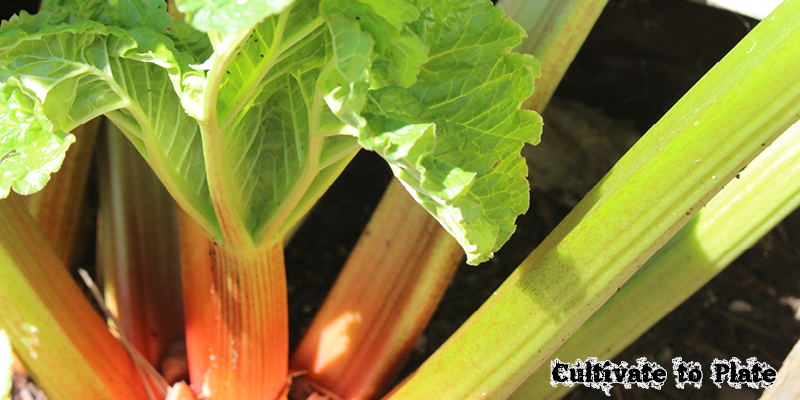Rhubarb: Pie Plant Stalk Vegetable
Rhubarb is a perennial plant that grows from rhizomes. The leaves are huge and decorative (and poisonous). The stalks, or petioles, come in red, green, or speckled. The color doesn’t matter with rhubarb as far as flavor goes, and red and green can be used interchangeably in recipes. It is often referred to as ‘pie plant’ because it is so suited for pie filling with it’s sweet-tart unique flavor.
Rhubarb Varieties
Rhubarb comes in different colored stalks depending on the variety: red, green, specked. Speckled rhubarb has shades of red fading to green or green stalks with red overlays.
Red Rhubarb Varieties
- Crimson Red – Red colored stalks, tender and tall petioles.
- MacDonald – Bright red or bright pink color, high yield variety.
- Cherry Red – Bright red stalks, inside and out.
- Valentine – Deep red color that resists fading when processed, excellent flavor.
Green Rhubarb Varieties
- Victoria – Shades of red at the base of the stalks that fades to green at the leaf tips, great cooking variety with tender stalks.
- German Wine – Green stalks with bright pink speckling at the base.
Growing Rhubarb
Dormant rhubarb crown roots are planted in early spring, spaced about 3 feet apart and in an area that can allow for their very large leaf space. Cover them with an inch of soil and pat down. Water a couple times a week, ensuring each time that the root ball gets enough water. Lest frequent deep watering is better for the plant than frequent shallow waterings. Depending on the variety, some rhubarb will send out flower shoots. Trim these as soon as you see them as they take away from stalk production. Rhubarb is perennial and will come back year after year.
After a period of time it is necessary to thin out your rhubarb and replant the rhubarb patch, typically every 5 to 10 years. You will notice the leaf stems become more narrow, the leaves will be small, and the plants become overly crowded. When this happens, you need to thin it out. Dig up the root crown before the spring growth starts and cut it into sections ensuring there is at least one large bud to each cut section. Then, plant as new crowns.
Harvest and Storage of Rhubarb
Don’t harvest rhubarb stalks for the first year of growth after planting to ensure root health. The second year, you may harvest a small amount of stalks (light harvest), and after the third year you may harvest as needed, keeping one third of the plant uncut at any given time. If you want to keep your rhubarb growing all season, pick a few stalks from each plant at each harvest, weekly or biweekly, which keeps the rhubarb almost at full growth all the time.
Rhubarb leaves contain oxalic acid and are poisonous. Cooking them will NOT make the leaves safe to eat. When harvesting rhubarb, trim the leaves completely off the stalks before using in recipes. The rhubarb leaves, although poisonous to eat, are fine to add the compost pile. The stalks are safe to eat. But note if the plant freezes at any point during growth, the rhubarb becomes unsafe to eat as the oxalic acid travels to the stalk.
Rhubarb can be kept after harvest in the refrigerator for about 2 to 3 weeks, loosely wrapped in plastic. If freezing rhubarb for later, blanch in boiling water first then shock in ice water. Drain well, pat dry, and freeze in plastic containers.
Cooking with Rhubarb
Rhubarb is Vitamin C rich with a sweet-tart flavor that makes it perfect for summer desserts as pie filling or dessert sauces. Here are three recipes to try below.
This basic rhubarb sauce is adapted from the University of Alaska Cooperative Extension Service:
Cut enough cleaned rhubarb into 1 inch pieces to equal 1 quart. Stew the rhubarb in 1/2 cup of water for 5 minutes or until tender. Fruit juice can be substituted for the all or part of the water. Add sweetener as desired. Raisins can be added for variety and to sweeten the sauce. Spices such as mace, nutmeg, or cinnamon can be used. Rhubarb sauce makes a good ice cream topping or a sauce on chicken, pork, or fish.
- 3/4 cup to 1 cup of sugar
- 2 tablespoons cornstarch
- 4 cups sliced rhubarb
- 1 tablespoon water
- Butter couple of tablespoons
- Cinnamon for sprinkling
- 1 cup all-purpose flour
- 1 tablespoon sugar
- 1 1/2 teaspoons baking powder
- 1/4 teaspoon salt
- 1/4 cup butter
- 1/4 cup milk
- 1 egg
- Sugar for sprinkling
-
Place the sliced rhubarb and water in a medium saucepan. Mix the sugar and cornstarch together and add this to the rhubarb mixture. Bring this to a boil, and cook for 1 minute. Pour out into a greased 13x9 inch baking pan, and dot with butter. Sprinkle with cinnamon as desired.
-
Sift the flour, sugar, baking powder, and salt together. Cut in the butter until it looks like coarse crumbs. Mix the milk and egg in a small mixing bowl, and pour this over the flour mixture. Stir ingredients to moisten them, but do not overmix. Drop by spoonfuls over the top of the cooked rhubarb. Sprinkle with sugar. Bake in a preheated 400 degree F oven for about 20 minutes, until the cobbler biscuit topping is browned and done, and the rhubarb is bubbly.
-
Serve warm or cold.
Adapted from Rhubarb Production in California
- 10 stalks rhubarb trimmed, and sliced into 1 inch pieces
- 4 cups hulled and quartered strawberries
- 1 1/2 cups sugar
- 1 cup orange juice fresh squeezed
- Grated zest of one orange
- Grated zest of one lemon
- 1/2 teaspoon vanilla extract
-
Combine all ingredients in a large, heavy saucepan. Bring to a boil, then reduce heat. Simmer for about 10 minutes, skimming foam as it forms.
-
Remove from heat and cool to room temperature. Cover and chill. Serve topping warm or cold.
Adapted from University of Illinois Extension
Share this:
- Click to print (Opens in new window)
- Click to email a link to a friend (Opens in new window)
- Click to share on Pinterest (Opens in new window)
- Click to share on Facebook (Opens in new window)
- Click to share on Tumblr (Opens in new window)
- Click to share on Twitter (Opens in new window)
- Click to share on LinkedIn (Opens in new window)
- Click to share on Pocket (Opens in new window)
- Click to share on Reddit (Opens in new window)



You must be logged in to post a comment.